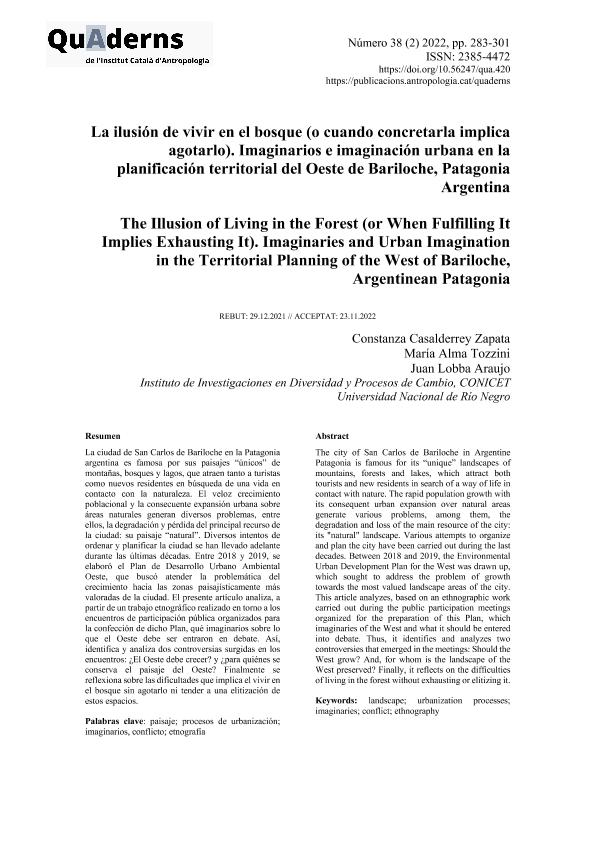Artículo
La ciudad de San Carlos de Bariloche en la Patagonia argentina es famosa por sus paisajes “únicos” de montañas, bosques y lagos, que atraen tanto a turistas como nuevos residentes en búsqueda de una vida en contacto con la naturaleza. El veloz crecimiento poblacional y la consecuente expansión urbana sobre áreas naturales generan diversos problemas, entre ellos, la degradación y pérdida del principal recurso de la ciudad: su paisaje “natural”. Diversos intentos de ordenar y planificar la ciudad se han llevado adelante durante las últimas décadas. Entre 2018 y 2019, se elaboró el Plan de Desarrollo Urbano Ambiental Oeste, que buscó atender la problemática del crecimiento hacia las zonas paisajísticamente más valoradas de la ciudad. El presente artículo analiza, a partir de un trabajo etnográfico realizado en torno a los encuentros de participación pública organizados para la confección de dicho Plan, qué imaginarios sobre lo que el Oeste debe ser entraron en debate. Así, identifica y analiza dos controversias surgidas en los encuentros: ¿El Oeste debe crecer? y ¿para quiénes se conserva el paisaje del Oeste? Finalmente se reflexiona sobre las dificultades que implica el vivir en el bosque sin agotarlo ni tender a una elitización de estos espacios. The city of San Carlos de Bariloche in Argentine Patagonia is famous for its “unique” landscapes of mountains, forests and lakes, which attract both tourists and new residents in search of a way of life in contact with nature. The rapid population growth with its consequent urban expansion over natural areas generate various problems, among them, the degradation and loss of the main resource of the city: its "natural" landscape. Various attempts to organize and plan the city have been carried out during the last decades. Between 2018 and 2019, the Environmental Urban Development Plan for the West was drawn up, which sought to address the problem of growth towards the most valued landscape areas of the city. This article analyzes, based on an ethnographic work carried out during the public participation meetings organized for the preparation of this Plan, which imaginaries of the West and what it should be entered into debate. Thus, it identifies and analyzes two controversies that emerged in the meetings: Should the West grow? And, for whom is the landscape of the West preserved? Finally, it reflects on the difficulties of living in the forest without exhausting or elitizing it.
La ilusión de vivir en el bosque (o cuando concretarla implica agotarlo): Imaginarios e imaginación urbana en la planificación territorial del Oeste de Bariloche, Patagonia Argentina
Título:
The Illusion of Living in the Forest (or When Fulfilling It Implies Exhausting It): Imaginaries and Urban Imagination in the Territorial Planning of the West of Bariloche, Argentinean Patagonia
Fecha de publicación:
01/2023
Editorial:
Institut Català d'Antropologia
Revista:
Quaderns de l'Institut Català d'Antropologia
ISSN:
1696-8298
e-ISSN:
2385-4472
Idioma:
Español
Tipo de recurso:
Artículo publicado
Clasificación temática:
Resumen
Palabras clave:
Paisaje
,
Procesos de urbanización
,
Imaginarios
,
Conflicto
Archivos asociados
Licencia
Identificadores
Colecciones
Articulos(IIDYPCA)
Articulos de INST. DE INVESTIGACIONES EN DIVERSIDAD CULTURAL Y PROCESOS DE CAMBIO
Articulos de INST. DE INVESTIGACIONES EN DIVERSIDAD CULTURAL Y PROCESOS DE CAMBIO
Citación
Casalderrey Zapata, Maria Constanza; Tozzini, María Alma; Lobba Araujo, Juan Mauricio; La ilusión de vivir en el bosque (o cuando concretarla implica agotarlo): Imaginarios e imaginación urbana en la planificación territorial del Oeste de Bariloche, Patagonia Argentina; Institut Català d'Antropologia; Quaderns de l'Institut Català d'Antropologia; 38; 2; 1-2023; 283-301
Compartir
Altmétricas




